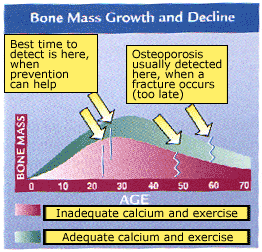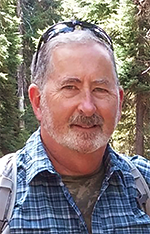Osteoporosis
Nearly 50% of American women
In their 30's and 40's are at risk for osteoporosis. Identifying your risk factors and current levels of bone loss can reduce the effects of this damaging disease.
What is Osteoporosis?
Osteoporosis is a "brittle bone" disease, occuring when excessive bone loss leads to gradual bone weakening. It is a silent disease which can go undetected for years. - until the damage is severe enough to cause a fracture. A broken hip or wrist often is the first symptom of osteoporosis. Have you ever observed the gradual loss in height and stooped posture of an elderly relative or friend? That's a typical sign of osteoporosis. Some bones, like the vertebrea in the spine, contain spongy bone tissue and are very susceptible to thining. Weakened vertebrae can crack and compress from even simple activities like bending to tie a shoelace. Eventually, these types of compression fractures lead to spinal deformities and loss of height.
How do bones change?

Your skeleton is living tissue, composed of cells embedded in a mineral matrix. Fresh bone is continually created to replace worn segments. In fact, your body's bones are completely replaced every 12 years. From childhood into your early 20's, your bones continue to grow because new bone formation outweighs bone loss. By your late 20's, your bones are as strong and thick as they will ever be. After age 35, bone building can no longer keep up with bone removal, and bone mass begins to decrease. No one understands why gradual bone loss occurs with aging. It is clear, however, that a dramatic increase in bone loss occurs during menopause.
What causes Osteoporosis?
Many factors contribute to bone loss. Small or petite women and women with relatives who have osteoporosis are at greater risk for developing the disease. Medical factors include menstrual irregularities, early menopause, certain diseases, stress and some medications. Lifestyle factors include lack of exercise, cigarette smoking, excessive alcohol consumption and crash dieting, or deficiencies in nutrients such as calcium, magnesium, trace minerals, B vitamins and vitamin D. A diet low in fiber and high in sugar or phosphates (as found in soft drinks) has also been linked to osteoporosis.
Who's at risk for osteoporosis?
Many more women than men get osteoporosis. According to the National Osteoporosis Foundation, nearly 50% of healthy American women in their 30's and 40's may be at risk for increased bone loss. One third of American women aged 50 and older are likely to suffer from spinal fractures. By the year 2000, osteoporosis will cause 500,000 hip fractures each year.
How do you Test for osteoporosis?
There are several tests for osteoporosis. One uses x-rays to assess bone mass. Another - a bone biopsy - requires an invasive surgical procedure. However, these only detect bone loss after it has occured. Dr. Bachman's Risk evaluation on the other hand, measures bone losss before is becomes a problem. Dr. Bachmans Risk Evaluation is safe, simple, and non-invasive. Dr. Bachman will give you a test kit, and you will have a urine sample measured for the rate of current bone loss, indicating the risk for future bone loss. The results will be sent to Dr. Bachman who will develop a plan to slow bone loss and rebuild bone. With early testing and treatment, osteoporosis can be beaten!
What About Insurance
Coverage for Naturopathic services depends on which company and which policy you have insurance through.
The insurance market is changing rapidly so it is difficult to keep track of which companies are covering
Naturopathic services.
Check with your insurance company, give us a call, or click here to contact us for further information.


